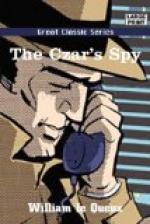When I inquired of the police-constable on duty at the town mortuary to be allowed to view the body of the murdered man, he regarded me, I thought, with considerable suspicion. My request was an unusual one. Nevertheless, he took me up a narrow alley, unlocked a door, and I found myself in the cold, gloomy chamber of death. From a small dingy window above the light fell upon an object lying upon a large slab of gray stone and covered with a soiled sheet.
The sight was ghastly and gruesome; the body lay there awaiting the official inquiry into the cause of death. The silence of the tomb was unbroken, save for the heavy tread of the policeman, who having removed his helmet in the presence of the dead, lifted the end of the sheet, revealing to me a white, hard-set face, with closed eyes and dropped jaw.
I started back as my eyes fell upon the dead countenance. I was entirely unprepared for such a revelation. The truth staggered me.
The victim was the man who had acted as my friend—the Italian waiter, Olinto.
I advanced and peered into the thin inanimate features, scarce able to realize the actual fact. But my eyes had not deceived me. Though death distorts the facial expression of every man, I had no difficulty in identifying him.
“You recognize him, sir?” remarked the officer. “Who is he? Our people are very anxious to know, for up to the present moment they haven’t succeeded in establishing his identity.”
I bit my lips. I had been an arrant fool to betray myself before that man. Yet having done so, I saw that any attempt to conceal my knowledge must of necessity reflect upon me.
“I will see your inspector,” I answered with as much calmness as I could muster. “Where has the poor fellow been wounded?”
“Through the heart,” responded the constable, as turning the sheet further down he showed me the small knife wound which had penetrated the victim’s jacket and vest full in the chest.
“This is the weapon,” he added, taking from a shelf close by a long, thin poignard with an ivory handle, which he handed to me.
In an instant I recognized what it was, and how deadly. It was an old Florentine misericordia, a long thin, triangular blade, a quarter of an inch wide at its greatest width, tapering to a needle-point, with a hilt of yellow ivory, the most deadly and fatal of all the daggers and poignards of the Middle Ages. The blade being sharp on three angles produced a wound that caused internal hemorrhage and which never healed—hence the name given to it by the Florentines.
It was still blood-stained, but as I took the deadly thing in my hand I saw that its blade was beautifully damascened, a most elegant specimen of a medieval arm. Yet surely none but an Italian would use such a weapon, or would aim so truly as to penetrate the heart.
And yet the person struck down was a woman, and not a man!




